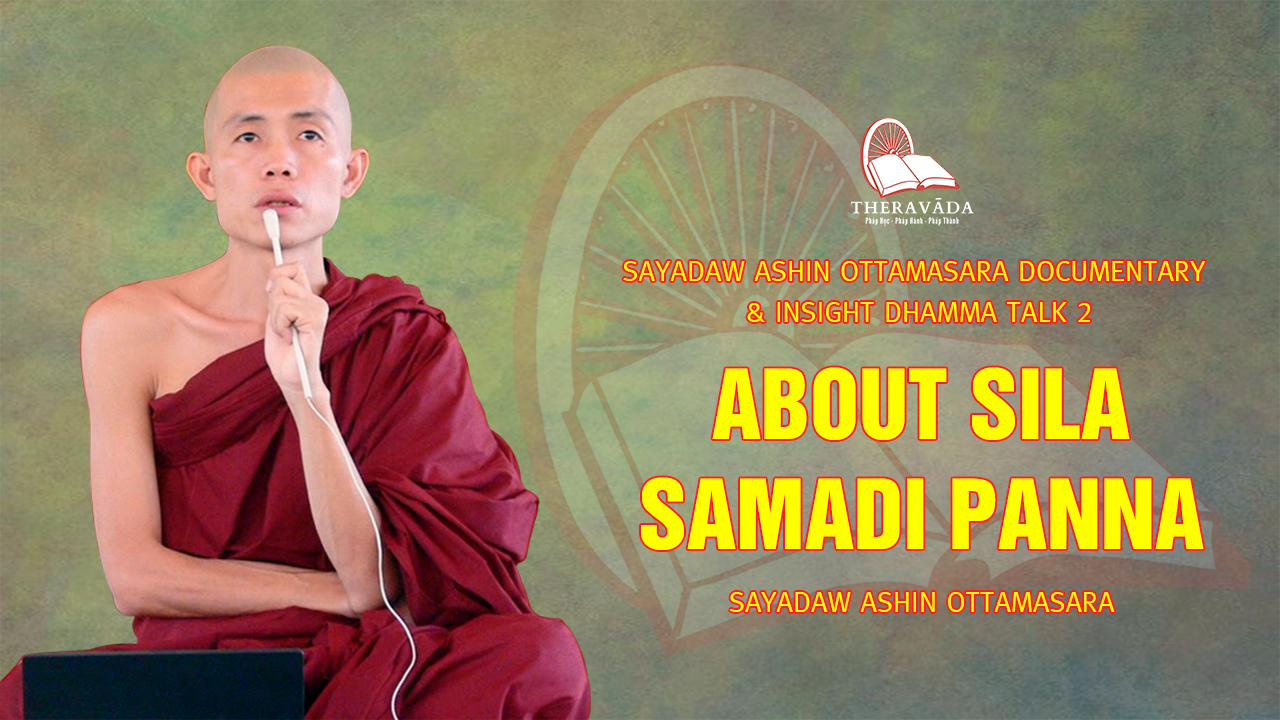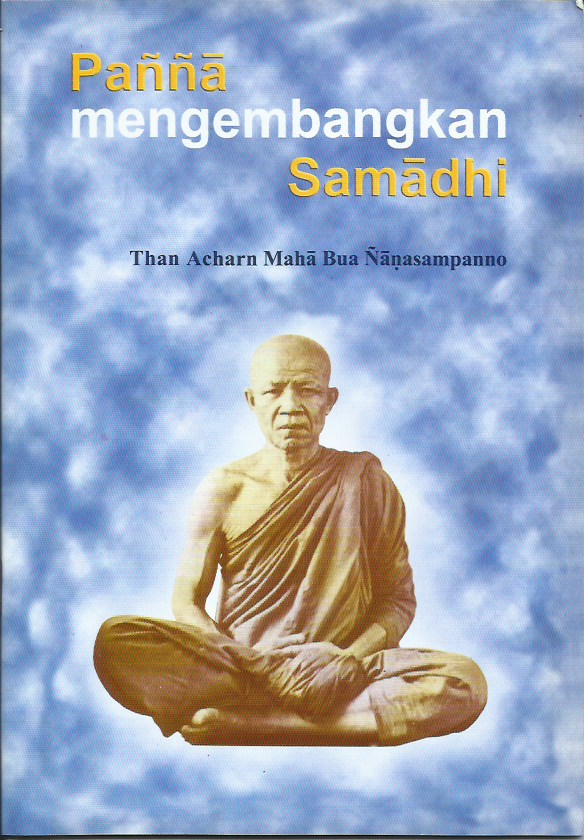
Offering sila, samadhi and panya (1981) Amaravati Buddhist Monastery
The Threefold Training (Sila, Samadhi, Prajna) The Threefold Training or Practice isn't successive it's integrated and interconnected. All with the goal of showing you your Original Essence or Buddha Nature. The Threefold Training includes Sila, Samadhi and Prajna.

Sila, Samadhi, Panna YouTube
8. Right collectedness (samma samadhi) Even these three aspects of the Path, although identified separately for clarification, are not separate. In actual practice, with proper understanding, sila, samadhi and pañña are assimilated in each moment, in every thought, word or deed. Take, for instance, sila, or ethical conduct.

Wesak Dana Sila Samadhi Panna The Path Amaravati Buddhist Monastery
S ila, samadhi and panna are the names given to the different aspects of the practice. When you practise sila, samadhi and panna, it means you practise with yourselves. Right sila exists here, right samadhi exists here. Why? Because your body is right here! You have hands, you have legs right here. This is where you practise sila.

Ajahn Sumedho / 108 Talks / 6/108 Offering sila, samadhi and panya
Sīla and sati are a condition for samādhi. They form the fertile soil in which samādhi can take root. The Development of Samādhi (Concentration) In his teaching Ahba emphasizes the practice of samatha meditation. Samatha means as much as calm and is synonymous with concentration ( samādhi).

Video 99. About Sila Samadi Panna Sayadaw Ashin Ottamasara
Samadhi: Translated as concentration, calm abiding, or mindfulness, samadhi is the foundation of Buddhist meditation. By settling and calming the mind through dedicated meditation practice, we achieve peace and are no longer controlled by our delusions and conflicting emotions ( kleshas ).

Finding Our destiny by practicing the idea of Plan Do Check Act (PDCA
A Dhamma Talk by Ajahn Chah Sìla, Samádhi, and Paññá as edited by David Dale Holmes I practised Dhamma without knowing a great deal. I just knew that the path to liberation began with virtue (sìla). Virtue is the beautiful beginning of the Path; the deep peace of samádhi is the beautiful middle; wisdom (paññá) is the beautiful end.

Video 130. Conquering Oneself With Sila Samadhi And Panna U Paṇḍitā
1.2.1 Cultivation and liberation. As explained in discourses like the (Ti) Sikkhā Sutta (A 3.88), the set of 3 trainings of moral virtue (sīla), mental concentration (samādhi), and wisdom (paññā), is a practic-al formula, leading us from our present state, through a cultivated state, into a liberated state. Spiritual development.

Citta, Sila, Samadhi, Panna Emeritus Professor Sumanapala Galmangoda
Threefold Training The Buddha identified the threefold training ( Sanskrit: triśikṣā; Pali: tisikkhā; or simply śikṣā or sikkhā) [1] as training in: higher virtue (Pali adhisīla-sikkhā, Skt. adhiśīlaśikṣa) higher mind (Pali adhicitta-sikkhā, Skt. samādhiśikṣa) higher wisdom (Pali adhipaññā-sikkhā, Skt. prajñāśikṣa) In the Pali Canon

Buddhism for you lesson 07noble eightfold path
Theravāda is a major branch of Buddhism having the the Pali canon ( tipitaka) as their canonical literature, which includes the vinaya-pitaka (monastic rules), the sutta-pitaka (Buddhist sermons) and the abhidhamma-pitaka (philosophy and psychology). Discover the meaning of sila samadhi panna in the context of Theravada from relevant books on.

Berdana dengan Sila, Samadhi dan Panna
Wisdom (paññā) Right view Right resolve For more information: Noble Eightfold Path My questions are: Which is the correct sequence out of the above two? Which sequence to follow? eightfold-path sila samadhi panna Share Improve this question Follow

The Eight Auspicious Symbols Buddhist symbols, Symbols, Dharma wheel
These eight factors aim at promoting and perfecting the three essentials of Buddhist training and discipline: namely: (a) ethical conduct (s ila ), (b) mental discipline (s amadhi) and (c) wisdom ( panna ).

Pañña mengembangkan Samādhi After Singapore
Sila (1), samadhi (2) and panna (3) form the basic constituents of the teaching of the Buddha. They are the fundamental elements of his forty-five year teaching mission, during the course of his carika. Do these three aspects constitute his unique contribution to human civilization?

Anapanasati, Vipassana, Metta Bhavana Sila Samadhi Panna Happy
1. These days, it is customary to state that the Noble Eightfold Path consists of three steps: sīla (moral conduct), samādhi (Concentration), and paññā (wisdom). However, that sequence holds only for the mundane Eightfold Path. It does not lead to Nibbāna but only sets the conditions to get into the Noble Eightfold Path.

What is Sila, Samadhi, and Panna? Buddha Teaching Dhamma shorts
Sīla, Samādhi, Pañña Ajahn Amaro from the Thai forest tradition, a monastic, a monk of close to 40 years now broke down the the Four Noble Truths in medical language, and the way that he characterized it was that these four truths roughly parallel in medicine, a diagnosis, the cause or etiology, the prognosis (where it's going), and the treatment.

Lord Buddha explains Path To End of Suffering (Vipasana Meditation
Sila, samadhi, panna form the main bases of the Buddha's discourses. Therefore, this foreword will deal with sila, samadhi, panna. What is sila ? Sila is good practice. A good practice is a practice that keeps one well and benefits one. How does it keep one well? Sila keeps one from killing, stealing, committing adultery, taking intoxicants.

Video 8. The Virtues Of Sila, Samadhi, Panna U Paṇḍitā Sayadaw 11th
Sila, Samadhi & Pañña. October 1, 2018 Courtney Purcell. While sitting before the large Buddha image at the temple the other evening, Ajahn Khamjan and I were talking about the importance of putting into practice the Buddha's Noble Eightfold Path, which can be broken down into its three constituent parts: sila, samadhi and pañña. I'll.